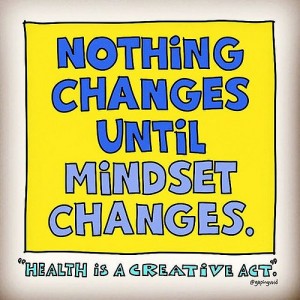“Okay class, it’s time to talk about mental health. For this unit, we’ll be discussing major depressive disorder, general anxiety disorder, bipolar disorder, substance abuse, and…” Meanwhile, the class of apathetic high school students decides to check their phones, attempt to nap, or pull out some math homework. The students have already concluded that this unit won’t have any relevance to their lives. Yet these same students will go on to sleep for five hours a night, constantly stress about tests, struggle to live up to parental or societal expectations, and fail to find intrinsic value in many of their daily activities. But as long as they don’t fit the diagnostic criteria for the mental illness categories, they’re perfectly healthy. Right?
This belief that individuals who suffer from mental disorders are the only ones who should focus on their psychological and emotional wellbeing is both wrong and dangerous. It harms people with diagnosable mental illnesses by increasing stigma and isolation. When society perceives that mental health concerns are only important for an abnormal subset of the population, struggling individuals suffer from internal and external pressures that stop them from admitting mental health problems.
Moreover, the idea that mental health concerns only apply to those who are unhappy harms people without diagnosable mental illnesses by suggesting that mental health is not their issue. At a time when American college students report all-time lows in overall mental health and emotional stability (and the average high school student may be as stressed as psychiatric patients in the 1950s), it is clear that issues concerning mental health are not exclusively faced by a small minority of individuals. While it is imperative to help individuals with diagnosable mental illnesses reduce their suffering, this is not enough. Solving the mental health crisis that modern students face is not only about reducing the prevalence of mental illnesses—it is about redefining the levels of anxiety and depression that are considered “okay” or “normal.” It is about remembering that mental health exists as a spectrum—and we can all work towards improvement regardless of where we fall on that continuum. It is about recognizing that surviving is different than thriving; it is about actively pushing ourselves and others not to settle for the meager level of wellbeing that modern society considers typical.
It is about recognizing that mental health is our issue too.
What is Mental Illness?
It is tempting for us to view mental illness in the same way society views physical illness. In one sense, this analogy accurately recognizes that mental illnesses are not merely conditions that people can “snap out of.” However, this comparison also perpetuates the idea that mental illnesses are rigidly defined, distinct entities. Mental illnesses, unlike most physical illnesses, exist as a spectrum of symptoms.
The Diagnostic and Statistical Manual of Mental Illness (DSM-V) diagnoses mental disorders by evaluating the severity of symptoms that individuals possess. The specific symptoms described tend to be common, relatable concepts that affect everyone to some extent. For instance, the diagnostic criteria for major depressive disorder includes symptoms like “decreased interest or pleasure in most activities,” “change in sleep,” “guilt/worthlessness,” “diminished ability to think or concentrate,” and “fatigue or loss of energy.” If these symptoms sound relatable, it is because they are—especially at universities.
In an interview with the HPR, Harvard Professor of Psychology Joshua Buckholtz explained that psychopathological symptoms “are not mysterious, other-worldly phenomena—they are simply what ‘normal’ aspects of cognition, motivation, and social/emotional experience look like when pushed to one end of a continuous distribution of functioning.” Therefore, these “mental illness markers” are not qualitatively different from typical symptoms that individuals face on a regular basis. What makes mental illness a category of its own is the fact that familiar suffering is pushed to extremes in both intensity and duration. However, the same symptoms of mental illness are present, to milder degrees, in the overall population.
There’s much discussion about how college can be stressful, but it is less common to think about how high stress, sleep deprivation, and loss of motivation and energy relate to mental illness. A competitive and demanding culture has become the norm for many students at Harvard, along with universities across the country. A 2009 poll conducted by mtvU and the Associated Press found that 85 percent of college students experience daily stress. When asked to reflect over a two week period, 69 percent reported feeling tired “several days, more than half of the days, or nearly every day,” 42 percent report feeling down, depressed, or hopeless, and 38 percent expressed little interest of pleasure in doing things. Because many of these individuals do not have a diagnosable mental illness, their suffering is often downplayed, overlooked, or invalidated. In order to combat this problem, it is crucial that students work towards building communities that reduce stigma for both mental illness and common psychological battles that confront the wider student bodies.
How Do We Get Better?
1) Avoid Settling for “Normal”
A recent Harvard Crimson article described the social and intellectual pressures that cause nearly all Harvard students mental distress: the demanding and competitive environment can pressure students to maintain “the appearance of normalcy but the reality of distress.” This illusion of flawlessness creates scenarios in which everyone tries his or her hardest to impress everyone else, yet no one feels comfortable admitting imperfections. When each individual feels he or she needs to take on more stressors and put on a veil of happiness, students perceive an environment in which everyone is ‘Doing fine, how about you?’ Students feel like those around them are more worthy or more capable, and no one feels comfortable asking for help. The same reasoning explains why the richest and the happiest countries also have the highest suicide rates. When people who are struggling believe that everyone around them is prospering, the relative comparisons tend to induce more unhappiness.
On college campuses where “normalcy” involves secretly hiding all-time lows in mental and emotional health, we need to redefine what we accept as normal. Recent initiatives such as Harvard Speaks Up, #howwasyourdayHarvard?, and a Harvard Crimson article titled How Are You, Actually? encourage students to engage in this culture-redefining dialogue—but what should this dialogue include? Most notably, we need to recognize our limits. We need to honestly and critically evaluate our course load, extracurriculars, and social groups to identify harmful or mentally taxing stressors.
While it can be hard to challenge our own beliefs or those of our friends, it is necessary to ask these questions in order to maximize our mental and emotional wellbeing. We cannot allow ourselves to live in a culture of academic martyrdom, in which one’s tolerance for suffering is esteemed—and even envied. Is it really in our best interest to take those five problem set courses? Should we feel embarrassed about craving free time?
2) Talk to a therapist therapists
If we accept the claim that mental illness exists as a spectrum, it makes sense that we would expect symptom-targeting treatments to benefit the general public. Buckholtz substantiated this claim by clarifying that treatments can be used to reduce stress or dispel harmful beliefs “even in people who would not otherwise meet the diagnostic criteria for mental illness.” As a result, it is plausible that treatments designed to reduce symptoms in mental illness can reduce unhealthy symptoms in members of the general population.
Unfortunately, unhealthy symptoms often are not easily detectable until they manifest into a mental illness. But just as we would not wait until we were severely ill to go to the doctor, we should not wait until we are suffering to see a mental health professional. Harvard Professor Richard McNally, an expert on anxiety disorders, told the HPR that certain treatments focus on preventing disorders. Treatments that work to reduce symptoms in anxiety disorder have been modified in order to help people handle everyday stressors.
On the other hand, it is important to recognize that the field of psychology is vastly broad and ever-changing. Different therapists have different approaches (as well as different personalities) that influence the success of treatment. Jennifer Yao, President of Harvard’s Student Mental Health Liaisons (SMHL), told the HPR that she suggests students “try something else” if their experience with one particular service was unsatisfactory. Students with unhelpful or negative first experiences may think that therapy can’t help them without realizing that therapy consists of an extremely diverse set of scientific treatments, and an infinitely greater number of person-specific treatments. Just as students are encouraged to shop classes before committing, they should shop therapists and resources to identify their best-fit. Each resource has distinct strategies and personalities, which means they can appeal to different types of individuals and meet different kinds of needs.
Fortunately, Harvard has a great deal of mental health resources available—ranging from professional assistance, peer counseling, and residential support. Regarding professional assistance—which can usually offer the most significant long-term improvements to mental health—it is important to note that off-campus resources tend to have higher satisfaction rates than UHS. One potential explanation is that students aren’t encouraged to choose a UHS therapist; therapists at UHS are typically assigned after a brief questionnaire. When students use off-campus resources, they are far more likely to research specific therapists or seek recommendations from friends. Additionally, students are typically granted appointments bi-weekly or monthly; students who seek more frequent appointments typically benefit more from off-campus resources. Nevertheless, UHS remains a free and convenient first-step for those who wish to invest in their mental health.
3) Practice Mindfulness
Our understanding of mental illness rarely incorporates insight from eastern cultures. While Western societies often focus on medicating the physiological causes of mental illnesses, eastern philosophers often emphasize a broader cognitive and spiritual understanding of the mind via meditation and self-awareness. Meditation, for instance, has been shown to reduce stress and improve overall wellbeing. However, there can be risks associated with meditation, so it is important to meditate in moderation.
Harvard Professor James Robson—whose current research involves the influence of Buddhist philosophies on mental health hospitals in Japan—weighed in on the debate about meditation. Robson told the HPR that he believes some forms of meditation can be “really relaxing and de-stressing,” but he warned that sophisticated types of meditation—especially those most closely tied to Buddhist traditions—“were not directed towards stress reduction.” Robson recommends that individuals who meditate reflect critically on its impact on their wellbeing. Since there are various types of meditation, interested individuals may wish to self-experiment with a couple of meditation styles that appeal to their mental health goals.
Is Mental Illness Unique?
While individuals with mental illnesses can substantially benefit from mental health advocacy and treatment, they are not the only ones. This does not mean that we should invalidate other peoples’ suffering or pretend to fully understand their experiences; distress from getting a C on an exam is not equivalent to living with clinical depression. However, both moderate and extreme forms of suffering ought to be taken seriously, and both can be combatted with similar solutions.
The biggest concept to understand is that mental illnesses (especially mood disorders) are not clearly defined distinct categories, but rather spectrums of symptoms, many of which are highly relatable to the general population. The fact that certain symptoms are invalidated as a “normal” part of the college experience warps our understanding of mental health. We pretend that people with diagnosable disorders are the only ones with problems and that everyone else is fine. We view our mental health as perfect unless we pass the arbitrarily created symptom threshold. We forget that mental illnesses do not exist as distinct diseases that get cured; rather, they are natural human conditions that everyone experiences at some time to varying degrees. We are all individuals who exist along the spectrum for depressive disorders and anxiety disorders, and we can all benefit from active investment in our mental health.
Image credit: umjanedoan/flickr and MichaeldeGroot/flickr
